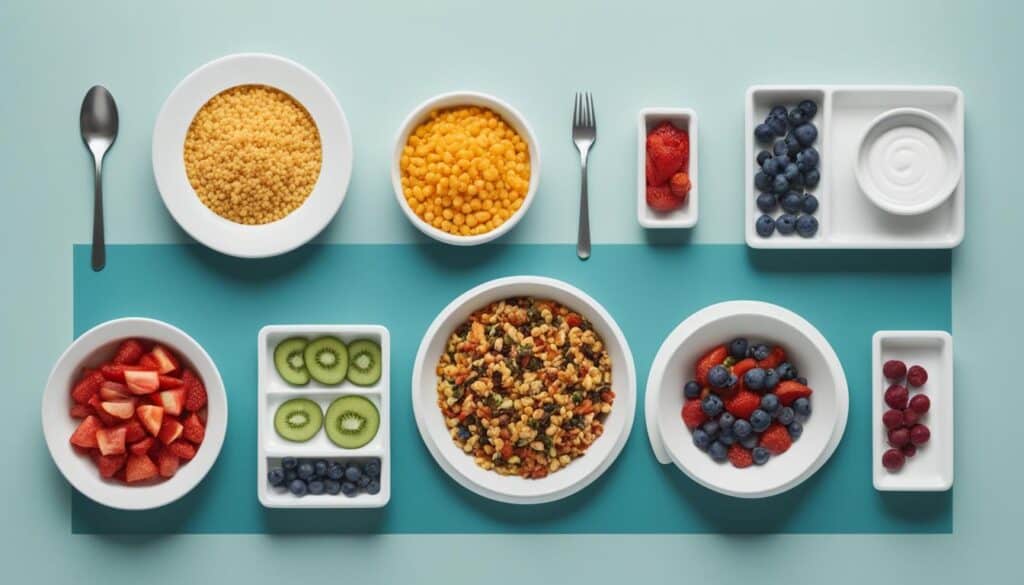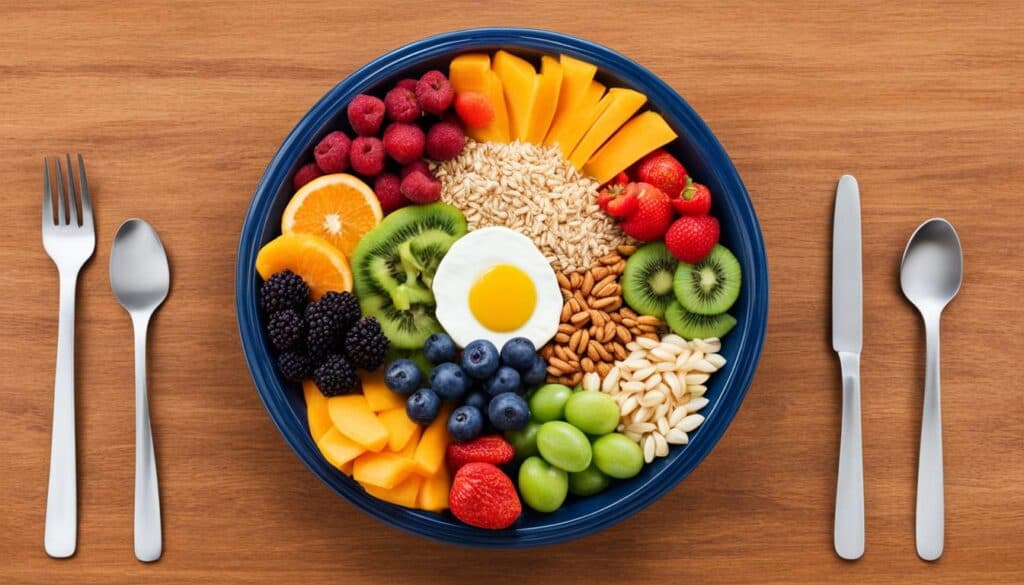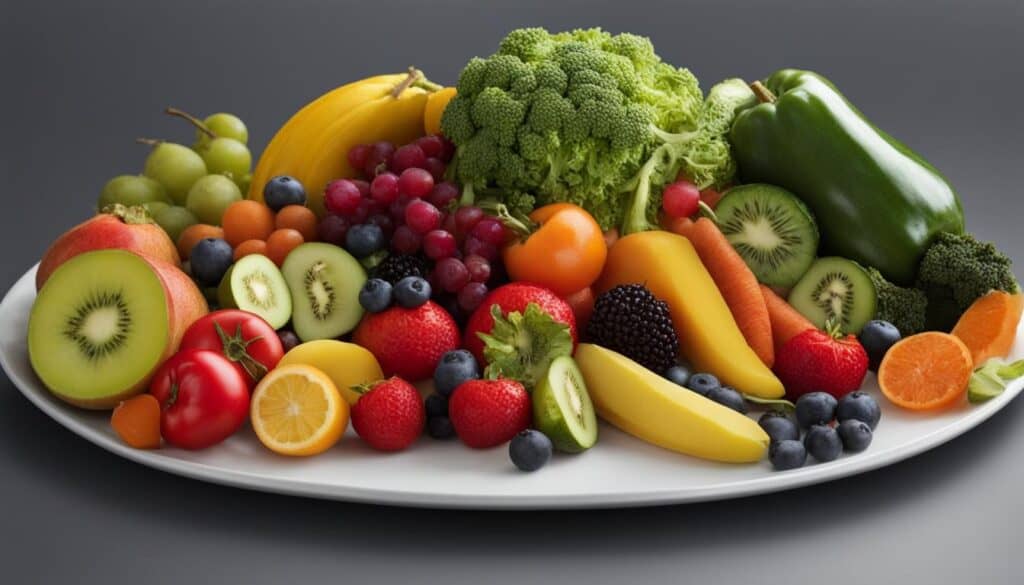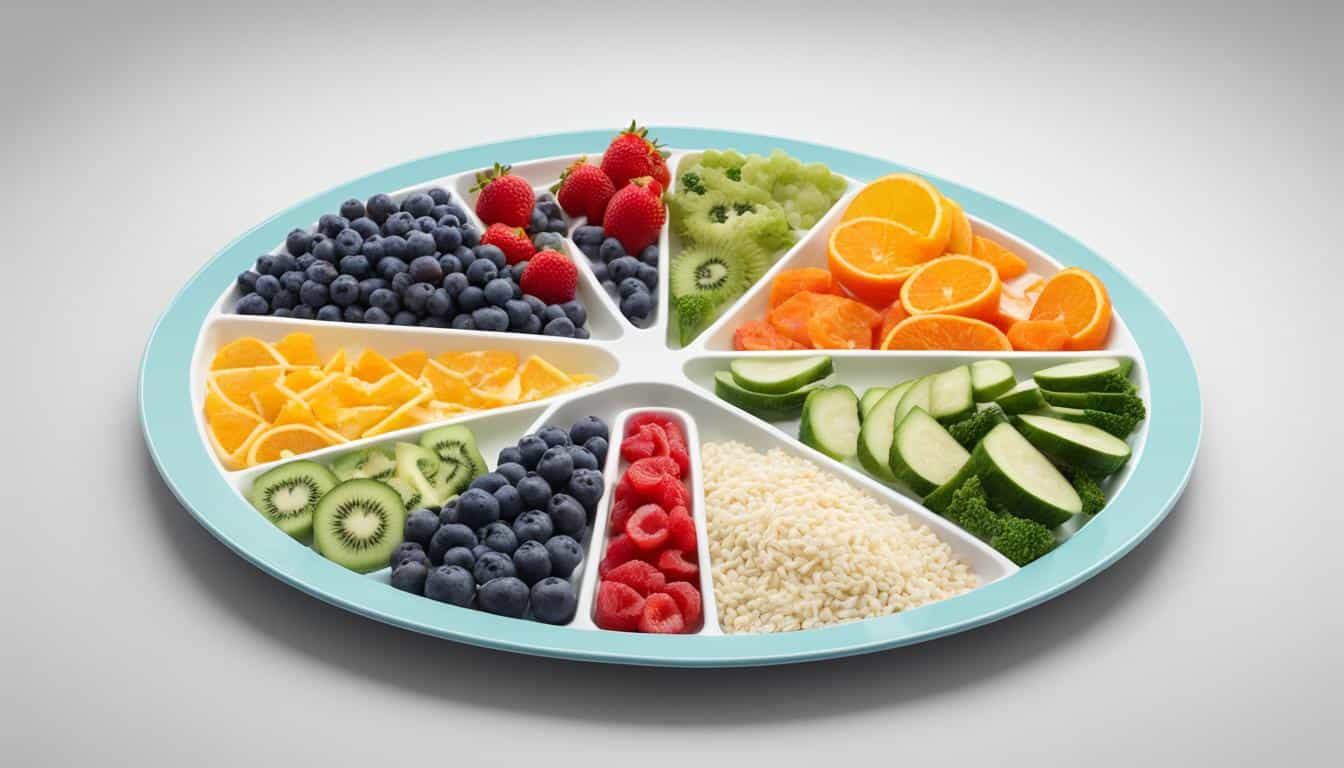Hi, I’m here to help you navigate the sometimes confusing world of food guide serving sizes. Understanding the difference between portion sizes and serving sizes is key to managing a balanced and healthy diet. Let’s dive in!
Portion sizes refer to the amount of food you eat in a single sitting, while serving sizes are standardized measurements recommended by food guides. By following recommended serving sizes, you can ensure that you are getting the right amounts of nutrients from each food group.
Visualizing serving sizes can be helpful in making informed food choices. For example, did you know that a serving of pasta is approximately the size of a tennis ball? Or that a small pat of butter is equivalent to a teaspoon serving size?
Maintaining healthy portion sizes is important for weight management and overall well-being. It’s recommended to consult with a healthcare professional to receive personalized recommendations based on your individual dietary needs.
Key Takeaways:
- Understanding the difference between portion sizes and serving sizes is crucial for managing a balanced diet.
- Visualizing serving sizes using everyday objects can help in portion control.
- Following the recommended daily servings from each food group ensures a well-rounded diet.
- Consulting with a healthcare professional can provide personalized recommendations.
- Practicing portion control and making informed food choices contribute to a healthy lifestyle.
The Difference Between Portion and Serving Sizes
When it comes to managing our diet, it’s important to understand the difference between portion sizes and serving sizes. While these terms are often used interchangeably, they have distinct meanings and play a significant role in maintaining a healthy lifestyle.
Portion sizes refer to the amount of food an individual consumes in one sitting. This can vary depending on personal appetite, activity level, and eating habits. For example, someone with a larger appetite may naturally have larger portion sizes compared to someone with a smaller appetite.
Serving sizes, on the other hand, are standardized measurements used to determine the nutritional information and recommended consumption of a particular food. These serving sizes are often provided on food labels and are typically based on average portion sizes consumed by individuals. They serve as a guideline for maintaining a balanced diet and managing calorie intake.
It’s important to be aware of a phenomenon known as “portion distortion.” This occurs when the suggested serving size is often smaller than what is commonly eaten or served, especially at restaurants. For instance, a restaurant serving of pasta may contain two or three times the recommended serving size. This distortion can lead to consuming excess calories and affect our ability to manage our weight and overall health.
Understanding the distinction between portion and serving sizes is crucial for maintaining a healthy diet. By being mindful of portion sizes and following the recommended serving sizes, we can better manage our calorie intake and ensure we are meeting our nutritional needs.
Recommended Daily Servings for Each Food Group
Following the recommended daily servings from each food group is essential for a balanced diet. These recommendations can vary depending on factors such as age, activity level, and weight goals.
Some general guidelines for daily servings include:
Grains and Starchy Vegetables
- 6-11 servings per day
Non-Starchy Vegetables
- 3-5 servings per day
Dairy
- 2-4 servings per day
Lean Meats or Meat Substitutes
- 4-6 ounces per day
Fruit
- 2-3 servings per day
Fats, Oils, and Sweets
Use sparingly.
It’s important to consult with a healthcare professional or dietitian to determine personalized daily recommendations based on your specific needs. They can provide expertise and guidance tailored to your individual dietary requirements.
Visual References for Serving Sizes
Visualizing serving sizes can be incredibly helpful when it comes to understanding how much food constitutes a recommended serving. By comparing serving sizes to everyday objects, we can gain a better sense of portion control and make informed choices about what we eat.
Here are some visual references that can assist you in visualizing serving sizes:
- A slice of bread is about the size of a DVD disc.
- One small pat of butter is equivalent to a teaspoon serving size.
- A serving of green peas is roughly half the size of a baseball.
Other visual references include:
- A serving of popcorn is three baseballs.
- A potato the size of a computer mouse is equivalent to one serving.
- A salad serving of greens is about the size of a baseball.
These visual comparisons can help you better understand recommended serving sizes and make more informed decisions about your food portions. By using everyday objects as references, you can develop a better sense of what constitutes a healthy serving and practice portion control.
Remember, understanding and visualizing serving sizes is just one step towards a balanced diet. Consulting with a healthcare professional or registered dietitian can provide personalized recommendations based on your individual dietary needs and goals.

Serving Sizes for Specific Foods
When it comes to managing our calorie intake and making healthier food choices, understanding the specific serving sizes for different types of foods is crucial. Here are some examples of serving sizes for specific foods:
- Pasta: A serving of pasta is approximately the size of a tennis ball.
- Olive oil: A serving of olive oil should be similar to the amount of one pat of butter.
Snacks also have specific serving sizes to consider:
- Peanut butter or candy: One 1-ounce shot glass is equivalent to a serving size.
- Bagel: A bagel the size of half a baseball is equal to one serving.
Visualizing Serving Sizes
Visual references can help us better understand the recommended serving sizes for specific foods. For example:
- A serving of pasta is approximately the size of a tennis ball.
- A serving of olive oil is similar to the amount of one pat of butter.
- A bagel the size of half a baseball is equal to one serving.
- One 1-ounce shot glass of peanut butter or candy is a serving size.
By visualizing these serving sizes, we can make informed decisions about our food portions and ensure we’re consuming the right amounts for a healthy diet.

Understanding these specific serving sizes can help individuals manage their calorie intake and make healthier choices.
Recommended Portions for Weight Management
Portion control plays a crucial role in weight management and achieving our desired body weight. While serving sizes provide a general guideline, it’s important to consider individual weight goals and make adjustments accordingly. For effective weight loss, reducing portion sizes and focusing on nutrient-dense foods with fewer calories can be beneficial.
When it comes to weight management, it’s essential to strike a balance between energy intake and expenditure. Portion sizes should be tailored to individual energy needs and activity levels. Consulting with healthcare professionals or registered dietitians can provide personalized recommendations for portion sizes and weight management strategies.
By following appropriate portion sizes for weight loss and consuming a balanced diet, individuals can fuel their bodies with the right nutrients while achieving their weight goals. Making conscious choices about portion control is a valuable tool in the journey towards a healthier and more balanced lifestyle.
Remember, portion control is a key component of successful weight management. By adopting healthy portion sizes and seeking professional guidance, individuals can make significant progress towards achieving their weight goals while maintaining overall well-being.
Serving Sizes for Children
Children have unique nutritional needs and require appropriate serving sizes for optimal growth and development. When determining serving sizes for kids, several factors such as age, activity level, and overall growth should be considered.
Younger children typically have smaller appetites and may require smaller serving sizes compared to adults. On the other hand, adolescents undergoing rapid growth may need larger portions to meet their nutritional needs.
Guidance from pediatricians and registered dietitians can help parents determine age-specific serving sizes for their children. These professionals can provide personalized recommendations based on individual factors to ensure children receive the necessary nutrients for healthy development.
Ensuring that children receive appropriate serving sizes helps establish healthy eating habits and supports their overall well-being.
Tips for Measuring Serving Sizes
Accurately measuring serving sizes can be a challenge, especially when eating out or in social settings. However, there are some helpful tips that can make portion control easier.
- Use Measuring Cups or a Food Scale: When available, using measuring cups or a food scale can provide precise measurements. This is especially useful when cooking or preparing meals at home.
- Visualize Serving Sizes: In situations where measuring tools are not accessible, visual cues can be helpful. For example, a deck of cards can roughly represent a recommended serving size for meat. A tennis ball can be used as a reference for grains.
- Practice Mindful Eating: Developing awareness of appropriate portion sizes and practicing mindful eating can contribute to a healthy and balanced diet. Paying attention to hunger and fullness cues and eating slowly can prevent overeating.
By utilizing these tips, you can improve your portion control and make more informed choices about how much you eat.
Visual References for Serving Sizes
| Food | Serving Size | Visual Reference |
|---|---|---|
| Bread | 1 slice | The size of a DVD disc |
| Butter | 1 small pat | Equivalent to a teaspoon |
| Green peas | 1 serving | Roughly half the size of a baseball |
| Popcorn | 1 serving | Three baseballs’ worth |
| Potato | 1 serving | The size of a computer mouse |
| Salad greens | 1 serving | The size of a baseball |
Visual references like these can assist you in measuring serving sizes accurately and practicing portion control.
Balancing Portion Sizes and Nutritional Needs
Achieving a balance between portion sizes and nutritional needs is key to maintaining a healthy diet. As I mentioned earlier, portion sizes refer to the amount of food you eat in a single sitting, while serving sizes are standardized measurements recommended by food guides. By understanding the difference between portion and serving sizes, you can make conscious choices about how much you eat.
One effective way to balance portion sizes is by listening to your hunger and fullness cues. This means paying attention to your body’s signals and stopping eating when you feel satisfied, rather than eating until you’re uncomfortably full. It’s important to eat mindfully and be aware of the amount of food you’re consuming.
Another crucial aspect of balancing portion sizes is considering your energy intake and physical activity level. It’s important to strike a balance between the calories you consume and the calories you burn through physical activity. This is key for weight management and overall well-being.
Following the recommended daily servings from each food group is also essential. By incorporating a variety of nutrient-dense foods into your diet, you can ensure that you’re meeting your nutritional needs while practicing portion control. It’s recommended to include grains, vegetables, dairy, lean meats, fruit, and healthy fats in your daily meals.
To further illustrate the importance of portion sizes and nutritional balance, here is a table showcasing the recommended daily servings from each food group:
| Food Group | Recommended Daily Servings |
|---|---|
| Grains | 6-11 servings |
| Vegetables | 3-5 servings |
| Dairy | 2-4 servings |
| Lean Meats | 4-6 ounces |
| Fruit | 2-3 servings |
| Fats | Sparingly |
This table provides a clear breakdown of the recommended servings for each food group. By following these guidelines and practicing portion control, you can maintain a healthy diet and ensure that you’re getting the necessary nutrients.
In conclusion, balancing portion sizes with your nutritional needs is essential for a healthy lifestyle. By being mindful of how much you eat, maintaining energy balance, and following the recommended daily servings from each food group, you can achieve a well-rounded, nutritious diet.

Importance of Consulting with a Professional
While general guidelines for serving and portion sizes exist, it’s essential to seek professional guidance and personalized recommendations based on individual dietary needs. Consulting with a healthcare professional or registered dietitian can provide expert advice and support, especially for individuals with specific health conditions or weight management goals.
These professionals have the knowledge and expertise to assess dietary requirements, offer personalized guidance on portion control, and tailor recommendations to fit individual needs. With their professional guidance, you can make informed decisions about your diet and ensure that you are on track to meet your nutritional goals.
Whether you are looking to lose weight, manage a medical condition, or simply improve your overall well-being, consulting with a professional can provide you with the personalized recommendations you need. They can help you navigate through the complexities of serving sizes, portion control, and dietary restrictions to create a plan that works best for you.
“Consulting with a healthcare professional or registered dietitian can provide expert guidance, especially for individuals with specific health conditions or weight management goals.”
By seeking personalized recommendations, you can benefit from the expertise of professionals who can guide you towards a healthier lifestyle. They can help you develop strategies to manage portion sizes effectively, choose nutrient-dense foods, and incorporate balanced meals into your daily routine.
Remember, everyone’s dietary needs are unique. What works for one person may not work for another. That’s why individualized, personalized recommendations are so valuable. By consulting with a professional, you can gain insight into your own nutritional needs and receive personalized guidance to help you make the best choices for your health and well-being.
Professional Guidance vs. Self-Directed Approach
While some individuals may choose to educate themselves and take a self-directed approach to their diet, there are significant benefits to seeking professional guidance. Here are a few reasons why consulting with a healthcare professional or registered dietitian is so important:
- Expertise: Professionals have extensive knowledge and training in the field of nutrition, allowing them to provide accurate and up-to-date information that is tailored to your unique needs.
- Personalization: Professionals can assess your individual dietary requirements and provide personalized recommendations that take into account your health goals, preferences, and any medical conditions.
- Accountability: Regular consultations with a professional can help keep you accountable to your goals, providing ongoing support and motivation throughout your journey.
Ultimately, consulting with a professional ensures that you receive personalized recommendations that are based on evidence-based research and tailored to your specific needs. They can provide you with the tools and guidance necessary to make sustainable changes to your diet and achieve long-term success.
| Benefits of Professional Guidance |
|---|
| Expertise |
| Personalization |
| Accountability |
When it comes to your health, investing in professional guidance can be a worthwhile decision. By working with a healthcare professional or registered dietitian, you can receive the personalized recommendations and support you need to achieve your nutritional goals and maintain a healthy lifestyle.
Conclusion
Navigating food guide serving sizes and practicing portion control are essential for maintaining a healthy diet and promoting overall well-being. By understanding the difference between portion sizes and serving sizes, individuals can make informed choices about their food intake.
Following the recommended daily servings from each food group, as outlined in food guides, ensures a balanced nutritional intake. Incorporating visual references, such as comparing serving sizes to everyday objects, can help individuals better visualize appropriate portion sizes.
Consulting with a healthcare professional or registered dietitian can provide personalized guidance and support in achieving nutritional goals. These professionals can help tailor recommendations based on an individual’s specific dietary needs, health conditions, and weight management goals.
By managing portion sizes, making conscious food choices, and seeking professional guidance when needed, individuals can develop healthy eating habits that contribute to their overall well-being.
FAQ
What is the difference between portion and serving sizes?
Portion sizes refer to the amount of food you eat in a single sitting, while serving sizes are standardized measurements recommended by food guides.
How can I visualize serving sizes?
Visualizing serving sizes can be helpful, such as comparing them to everyday objects like a baseball or shot glass.
What are the recommended daily servings for each food group?
The recommended daily servings include grains, vegetables, dairy, lean meats, fruit, and fats, and can vary depending on factors such as age, activity level, and weight goals.
Can you provide some visual references for serving sizes?
Sure! For example, a slice of bread is about the size of a DVD disc, while a serving of green peas is roughly half the size of a baseball.
What are some serving sizes for specific foods?
A serving of pasta is approximately the size of a tennis ball, and a serving of olive oil should be similar to the amount of one pat of butter.
How can portion sizes help with weight management?
Portion control is important for weight management. It’s recommended to reduce portion sizes and focus on consuming nutrient-dense foods with fewer calories.
Do children have different serving sizes?
Yes, children have different nutritional needs and serving sizes compared to adults. It’s important to consider factors such as age, activity level, and overall growth.
How can I measure serving sizes accurately?
Using measuring cups or a food scale can provide precise measurements, but when these tools are not available, visual cues like a deck of cards or a tennis ball can be helpful.
How can I balance portion sizes and nutritional needs?
Balancing portion sizes and nutritional needs is key to maintaining a healthy diet. Listening to hunger and fullness cues and making conscious choices about portion sizes can help.
Why is it important to consult with a professional?
Consulting with a healthcare professional or registered dietitian can provide personalized guidance and support based on individual dietary needs and goals.
What are the key takeaways for understanding food guide serving sizes?
Understanding the difference between portion and serving sizes, following recommended daily servings, using visual references, and seeking professional guidance are essential for managing a balanced diet.





Leave a Reply